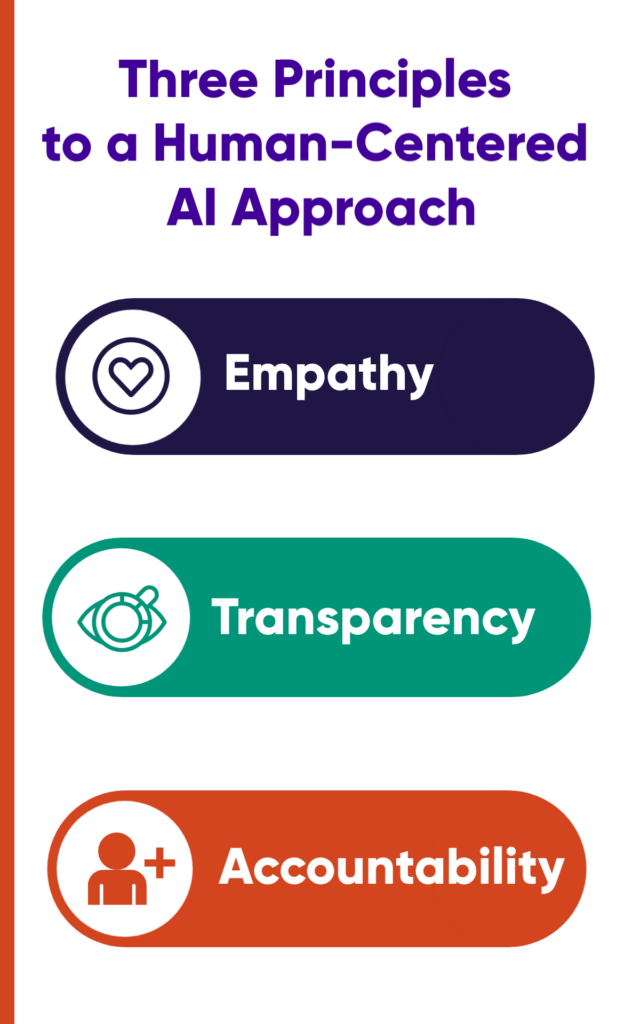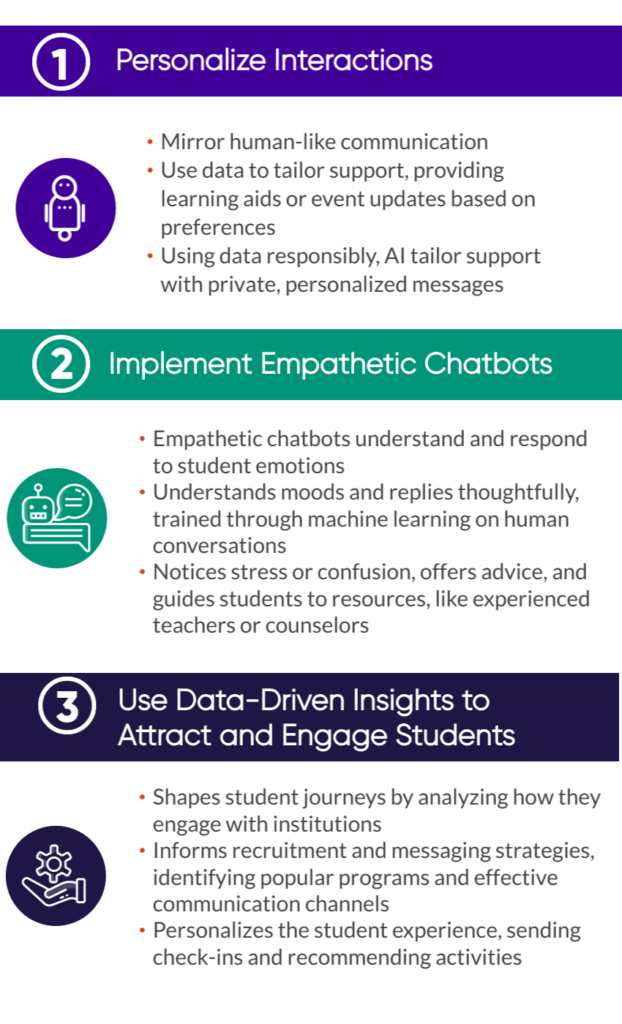Humanizing AI in Higher Education: Strategies to Maintain a Personal Touch

Bridging the Gap Between Technology and Personal Connection in Higher Ed
As artificial intelligence (AI)becomes ingrained in higher education, institutions face the challenge of leveraging its power while preserving the essential personal touch crucial for student success. This integration presents both significant potential and distinct challenges, especially in the context of humanizing AI.
What is Humanized AI and Why is it Important?
Humanized AI refers to artificial intelligence that is designed to interact with users in a way that feels personal and human-like. In the context of higher ed, this human element is critical. Students are not mere data points; they’re individuals with unique needs, preferences, and emotions.
Traditional AI-generated content often falls short in these areas, sometimes appearing out-of-touch with a brand’s identity, inconsistent tone and voice, or having biases contributing to inequalities, thus underscoring the need for a humanized approach.
At the core of humanizing AI is the drive to maintain the essence of human interaction—empathy, understanding, and personal connection. These elements are not only desired but expected by students who are increasingly seeking personalized and responsive educational experiences.
Three Foundational Principles to
a Human-Centered AI Approach
1. Empathy
Empathy plays a vital role in AI applications in education. It involves grasping students’ emotions and responding appropriately, like how a good teacher or advisor would. Empathetic AI can recognize student frustrations or confusion and respond supportively, cultivating a sense of connection and trust.
2. Transparency
Transparency is about being open with students regarding how AI systems operate and how their data is handled. This openness is a legal imperative and a trust-building measure, assuring students that their personal information is respected and protected.
3. Accountability
Lastly, accountability involves ensuring that AI applications are used ethically and are designed to be answerable for their actions. When AI systems are accountable, they help foster an environment of trust and reliability, which is crucial for their acceptance and effectiveness in educational settings.

Three Strategies to Maintain a Personal Touch with AI
1. Personalize Interactions
Personalized interactions are crucial for making AI more human-like in higher education. AI systems can use a lot of data, like grades, engagement, and preferences, to create personalized and caring communication. For instance, a student struggling in a subject could get specific learning help, and others might get updates on events they like. This personalization not only makes students feel noticed but also creates an environment that fits their learning and life.
By using data responsibly, AI can send personal messages in a private way. Picture a student getting congrats for doing well or a gentle reminder for a deadline—these personalized moments can really improve the student experience. It’s like having a digital campus that understands students and guides them just like a human advisor.
2. Implement Empathetic Chatbots
Chatbots are common in customer service, and in higher education, they do a similar job with an extra layer of complexity—providing empathetic responses to student needs. Empathetic chatbots are a big step in AI’s ability to get human emotions. By using machine learning on lots of human talks, these chatbots can figure out a student’s mood and what they want, giving fitting and thoughtful responses.
These chatbots can act like experienced teachers or counselors. They are set up to notice signs that show a student is stressed, confused, or needs help. They change their tone and give advice or resources based on the student’s needs. For example, if a student is worried about a deadline, the chatbot can give support, suggest managing time better, or guide them to mental health support if needed.
3. Use Data-Driven Insights to Attract and Engage Students
AI goes beyond just working efficiently—it also helps shape a student’s journey. AI can glean insights into student behaviors and preferences by examining data on how students seek out and interact with institutions. These insights become the backbone of a recruitment strategy and messaging approach aimed at attracting students and keeping them engaged throughout their academic careers.

For instance, data-driven insights can help institutions identify which programs are attracting the most interest and where additional marketing efforts might be fruitful. They can also reveal the most effective communication channels for reaching different student segments. On a more granular level, AI can help create content that resonates with current and prospective students by highlighting the success stories of alumni, showcasing innovative research projects, or promoting campus culture and diversity.
These insights can be used to personalize the student experience at every touchpoint. For example, AI could trigger a check-in message when a student hasn’t logged into the learning management system for an extended period or recommend extracurricular activities based on the student’s course selections and engagement patterns. This level of personal attention enhances student satisfaction and contributes to higher retention rates as students feel more connected and invested in their educational journey.
Tools Used for Humanizing AI
The diverse features and capabilities offered by AI programs provide a comprehensive suite of options for those seeking humanized AI interactions. As you explore the myriad AI programs designed to humanize interactions, here are three notable examples:
1. Bard
Google’s AI program, Bard, stands out by generating text that resonates on a human level. Bard can adapt its responses to align with the reader’s interests, facilitating personalized engagement.
2. Jasper
Jasper assists in crafting content that feels personal and relatable. By incorporating elements like anecdotes, it adds a touch of humanity to AI-generated text.
3. AI Writer
AI Writer ensures that content is not just informative but also conversational and easy to digest, mirroring the natural flow of human dialogue.
These tools represent the tip of the iceberg in a sea of evolving technologies aimed at bringing a personal touch to AI interactions. There are many other tools available, and the best tool for you will depend on your specific need.
Balancing Automation and the Human Touch
Striking the right balance between automation and human interaction is delicate. Too much reliance on AI can alienate students, while too little can overburden staff and reduce efficiency.
Automation should handle routine tasks, leaving humans to tackle complex, nuanced interactions. Simultaneously, it’s crucial that AI is used transparently and accountably, providing students with clear insights into how their data is used and the choice to opt out of AI-driven services.
Real Human Assistance with AI
While we strive to humanize AI in higher education, the presence of actual human support remains invaluable. Real human assistance ensures that the AI systems function within the ethical, empathetic, and personal parameters required for effective use.
The benefits are many: enhanced student support, personalized learning experiences, and streamlined administrative processes, all while maintaining the personal touch that fosters genuine student engagement.
At EducationDynamics, we value the efficiency and scale that comes with AI, while recognizing the irreplaceable value of human touch in higher education. EDDY’s team of real humans is equipped to aid universities in navigating the complexities of humanizing AI, ensuring that institutions can leverage these technologies while staying true to their core values of student-centric education.
To learn more about how to utilize AI within your institution, download our ebook, Leveraging AI to Supercharge Your Enrollment Marketing, a resource for universities to begin integrating human-centered AI into their marketing strategies. Going forward, it will be crucial for higher education institutions to ensure that as they step into the future of education, they do so with a balanced, ethical, and humanized approach.